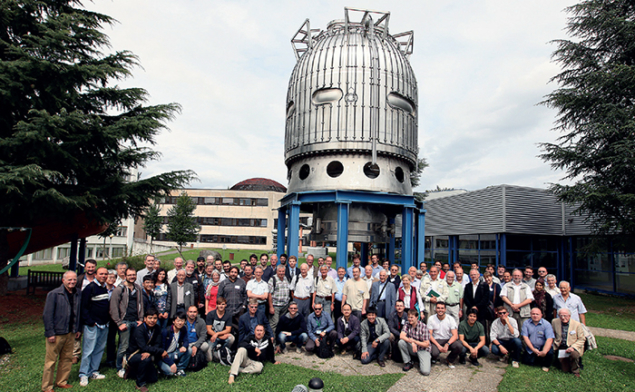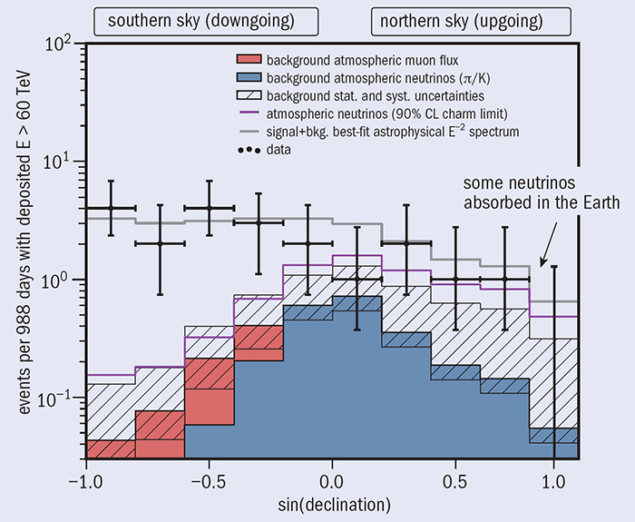More than 120 physicists from across the world met at CERN to discuss questions related to hadron production in cosmic-ray interactions and at accelerator experiments.

In August this year, CERN hosted the International Symposium on Very High Energy Cosmic Ray Interactions (ISVHECRI), the 18th meeting in the series that started in 1980 in Nakhodka, Russia, and is supported by the International Union for Pure and Applied Physics. In the early years, the symposia focused mainly on studying hadronic interactions of cosmic rays in the atmosphere and in emulsion chambers, which were the main cosmic-ray detectors at the time. The scope of the series has since widened, and it has become a frontier for scientists from both the cosmic-ray and high-energy physics communities to discuss hadronic interactions as a common research subject of the two fields.
At this year’s symposium, which was organized jointly by high-energy and cosmic-ray physicists – Albert de Roeck, Michelangelo Mangano and Bryan Pattison, of CERN, and David Berge of NIKHEF – the participants focused on the latest data on hadron production from CERN’s LHC, and the implications for interpreting cosmic-ray measurements. The LHC is the first collider to provide data at an equivalent proton–nucleon energy that exceeds that of the so-called “knee” – the observed change in cosmic-ray flux at 3 × 1015 eV, which is still to be explained. A series of review talks provided a comprehensive, cross-experiment overview of the latest LHC data, ranging from dedicated measurements of hadron production in the forward direction to a multitude of minimum-bias measurements in proton–proton and heavy-ion collisions. In addition, presentations showed how the forward measurements made at the HERA electron–proton collider at DESY have proved to be very useful for cosmic-ray studies. These reviews were complemented by an evening lecture on Higgs physics by John Ellis of Kings College London.

Image credit: Aab et al. 2014.
Tanguy Pierog of Karlsruhe Institute of Technology (KIT) and CERN’s Peter Skands reviewed the different approaches chosen for developing hadronic-interaction models for applications in cosmic-ray and high-energy physics. Even though the predictions of such models that were developed for cosmic-ray interactions turned out to cover the first LHC data rather well, some retuning was necessary, both to improve the description of the measurements at the LHC and to obtain more reliable high-energy extrapolations. The predictions of the models show an increasing convergence after such tuning, and lead to a more consistent description of air-shower data.
However, even the latest generation of interaction models does not solve the discrepancies found for the production of muons in extensive air showers at very high energy. A discrepancy in the number of muons at giga-electron-volt energies is seen, for example, in the data from the Pierre Auger Observatory on inclined showers whose electromagnetic component is absorbed in the atmosphere before reaching the detectors at the Earth’s surface (figure 1). Furthermore, data from the KASCADE-Grande experiment presented by Juan Carlos Arteaga of Universidad Michoacana, Morelia, indicate a much weaker attenuation of the muonic-shower component than expected from simulations. KIT’s Ralf Ulrich pointed out that, in contrast to the electromagnetic-shower profile, which depends on neutral-pion production in high-energy interactions only, both high- and low-energy interactions are important for understanding the production of muons in air showers. Therefore, measurements from fixed-target experiments such as NA61/SHINE at CERN and the Main Injector Particle Production experiment at Fermilab, which Boris Popov of JINR reviewed, are also important for obtaining a better understanding of muon production in air showers. Alternative scenarios for enhancing this muon production, involving extensions of the Standard Model, were discussed by Glennys Farrar of New York University.

Image credit: Aartson et al. 2014.
Many talks at the symposium illustrated the importance of multimessenger observations in astroparticle physics, for understanding not only the sources and the mass composition of cosmic rays but also a plethora of astrophysical phenomena. Examples are the review by Eli Waxman of the Weizmann Institute on different cosmic-particle accelerators and discussion of the propagation of ultra-high-energy cosmic rays by Andrew Taylor of the Dublin Institute for Advances Studies.
One highlight of the meeting was the discussion of high-energy neutrinos from astrophysical sources recently detected by IceCube (figure 2). Kota Murase of the Institute for Advanced Study, Princeton, reviewed different theoretical scenarios for the production of neutrinos in the tera- to peta-electron-volt energy range (1012 – 1015 eV). Tom Gaisser of the University of Delaware summarized the knowledge on neutrinos produced in interactions of cosmic rays in the atmosphere, which constitute the dominant background of non-astrophysical origin in the IceCube data. At peta-electron-volt and higher neutrino energies, the atmospheric lepton flux is dominated by the decay of charm particles, and LHC measurements on the production of heavy flavours are the only experimental data that reach the equivalent relevant energies. Given the limited acceptance in the forward direction at the LHC, QCD calculations and models are still of central importance for understanding high-energy neutrino production, as Victor Gonzalez of Universidade Federal de Pelotas and others discussed. Similarly, as Ina Sarcevic of the University of Arizona pointed out, calculating the interaction cross-section of neutrinos of energies up to 1019 eV is a challenge in perturbative QCD because of the need for parton densities at very low x. Anna Stasto of Penn State presented different theoretical approaches to understand low-x QCD phenomena, concluding that there is no multipurpose framework of general applicability.
The remaining uncertainties in predicting hadron production in high-energy interactions were one of the central questions discussed at the meeting, and highlighted by Paolo Lipari of INFN/Roma in his concluding remarks. There was general agreement that, in addition to ongoing theoretical and experimental efforts, the measurement of particle production in LHC collisions of protons with light nuclei, for example oxygen, would be the next step needed to reduce the uncertainties further.







